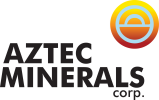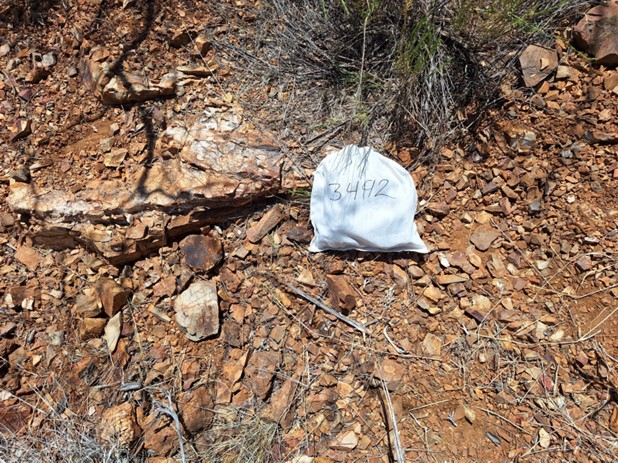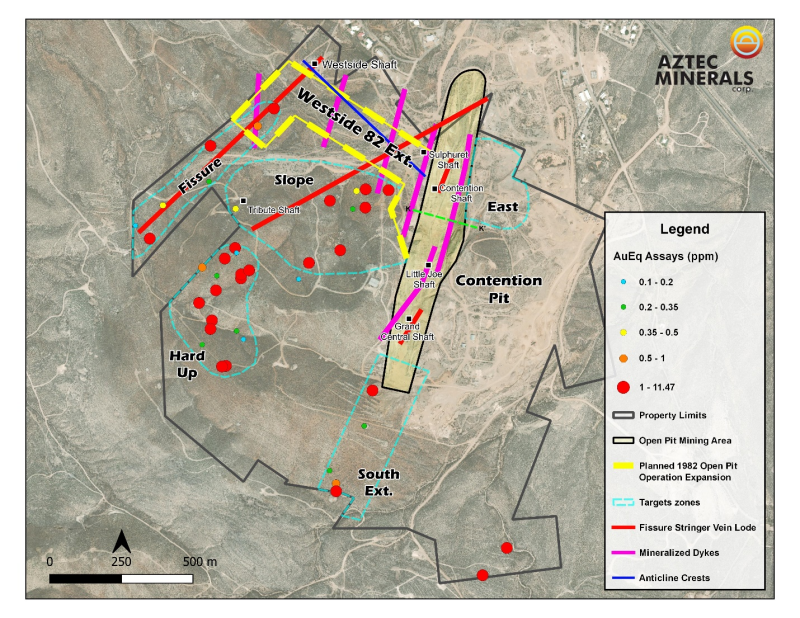Archive
Aztec Reconnaissance Sampling Program Further Expands High-Grade Gold & Silver Mineralization at the Tombstone Project in Arizona
 | |||||||||
-
Reconnaissance sampling over the Tombstone project patented claims returned +40% of samples with assays of above 1 gpt AuEq
-
High grade assays of 8.66gpt Au, 225 gpt Ag (11.47 gpt AuEq) and .94 gpt Au, 268 gpt Ag (8.29 gpt AuEq) indicates further potential to extend the mineralized footprint beyond the Contention pit zone
-
The program has confirmed that Au-Ag mineralization extends south of recently discovered the Westside Target Area
Vancouver, Canada – TheNewswire - July 16, 2024 - Aztec Minerals Corp. (AZT: TSX-V, OTCQB: AZZTF) (“Aztec” or the “Company”) announces that the assay results of the 2024 surface reconnaissance exploration program has discovered indications of broad gold-silver mineralization south of the Westside Target area and has discovered several additional mineralized zones outside of the Contention pit zone.
The field work verified specific, reported, key geologic, and historical mine features and found what could be potentially broad zones of alteration and mineralization for exploration west of the Contention Pit at the Tombstone project (which covers most of the historic Tombstone silver mining district in southeastern Arizona). Reconnaissance fieldwork has identified several, laterally broad zones of alteration associated with many of the samples taken in the recently reported pit sampling program (please see news releases dated: June 24, 2024 and July 2, 2024).
Reconnaissance Sampling Highlights:
-
Selected surface sample highlights include:
-
8.66 gpt Au, 225 gpt Ag (11.47 gpt AuEq) ~120m west fromNo. 3492, dump sample from a 1.0 m thick limestone layer in outcropping Bisbee Formation siltstone with moderate argillization and strong Mn oxides, moderate Fe oxides. Roughly 100m above the area of the Last Chance/Arizona Queen CRD orebody (sample # 3501).
-
4.94 gpt Au, 268.0 gpt Ag, (8.29 gpt AuEq) from a composite grab of outcropping Bisbee Formation siltstone with moderate silicification and argillization and strong quartz veinlets. The sample was taken ~100m above the area of the historic Last Chance/Arizona Queen CRD orebody. (sample # 3502)
-
3.79 gpt Au, 104.5 gpt Ag (5.10 gpt AuEq) from a 2.0m chip channel of outcropping Bisbee Formation siltstone with moderate silicification and argillization and strong quartz veinlets. The sample was taken ~100m above the area of the historic Last Chance/Arizona Queen CRD orebody. (sample # 3492)
-
1.33 gpt Au, 366 gpt Ag (5.91 gpt AuEq) from the Westside No. 1 shaft, a select sample of mineralized dump material, Bisbee Formation Hornfels with moderate argillization, strong iron oxides, moderate quartz veinlets. From the Westside fissure historic orebody (sample # 3459)
-
0.60 gpt Au, 360 gpt Ag, (5.10 gpt AuEq) from a shaft on the Westside fissure system, a select sample of mineralized dump material, Bisbee Formation Hornfels with moderate argillization, strong iron oxides, moderate quartz veinlets. (sample # 3460)
-
-
The reconnaissance sampling had 41% of the samples returning AuEq assays of over 1 gpt AuEq
-
The field work verified the surface locations of key features such as the mineralized and mined Boss dike, the Westside fissure, and Westside No. 1 and No. 3 shafts
-
The recently acquired knowledge of the mesothermal mineralization geological setting indicates a high potential for further discovery of wide oxide Gold Silver along strike and down dip of prospective hosting rocks outcropping in the Contention Pit areas (see Figure 1)
Figure 1: Tombstone 2024 Reconnaissance Sampling
Many of the high-grade gold-silver sample results are located immediately inside or adjacent to the Westside target area and indicate the strong potential to expand into multiple zones of broad Au-Ag oxide mineralization to the west.
The results of the Reconnaissance Sampling Program, illustrated in Table 1, supports the presence of broad, mesothermal, gold and silver oxidized mineralization and suggests the potential for further expansion of the mineralization footprint in the host formations down dip and along strike, including the potential extension westward of the historical Contention Pit
Table 1: Tombstone Reconnaissance Select Sampling Results*
|
Sample |
Au_ppm |
Ag_ppm |
AuEq |
Sample Type |
Lithology |
Alteration 1/Intensity |
Minz |
|
3451 |
0.55 |
176.00 |
2.75 |
Grab/Dump |
Quartzite |
Sil/Mod |
|
|
3452 |
0.18 |
125.40 |
1.74 |
Grab/ Dump |
Limestone |
Arg/Weak |
Vein |
|
3453 |
0.21 |
217.00 |
2.93 |
Grab/ Dump |
Limestone |
Arg/Weak |
Vein |
|
3459 |
1.33 |
366.00 |
5.91 |
Grab/ Dump |
HnFL |
Arg/Mod |
Vein |
|
3460 |
0.60 |
360.00 |
5.10 |
Grab/ Dump |
HnFL |
Arg/Mod |
Vein |
|
3463 |
0.71 |
237.00 |
3.67 |
Grab/Dump |
Sandstone |
Sil/Str |
Bx |
|
3464 |
1.13 |
94.40 |
2.31 |
Grab/Outcrop |
Hbx |
Sil/Mod |
Hbx |
|
3471 |
0.62 |
310.00 |
4.50 |
Grab/Dump |
Limestone |
Arg-Sil/Mod |
|
|
3476 |
0.65 |
52.80 |
1.31 |
Grab/Outcrop |
Hbx |
Arg-Sil/Str |
Hbx |
|
3477 |
1.05 |
43.20 |
1.59 |
Grab/Outcrop |
Hbx |
Arg-Sil/Str |
Hbx |
|
3479 |
0.09 |
90.30 |
1.22 |
Grab/Dump |
Limestone |
Sil-Arg/Weak |
|
|
3485 |
1.75 |
81.90 |
2.77 |
Grab/Outcrop |
Limestone |
Arg/Mod |
Vein |
|
3486 |
0.50 |
118.50 |
1.98 |
Grab/Outcrop |
Limestone |
Sil-Arg/Mod |
|
|
3487 |
1.08 |
47.20 |
1.67 |
Grab/Outcrop |
Hbx |
Arg-Sil/Strong |
|
|
3488 |
0.36 |
87.50 |
1.45 |
Grab/Dump |
Limestone |
Sil-Arg/Mod |
|
|
3489 |
2.18 |
19.00 |
2.42 |
Grab/Outcrop |
Quartzite |
Sil-Arg/Mod |
|
|
3490 |
2.24 |
13.30 |
2.41 |
Grab/Outcrop |
Siltstone |
Sil-Arg/Str |
|
|
3491 |
1.07 |
8.10 |
1.17 |
Channel/Outcrop |
Siltstone |
Sil/Mod |
Vnlts |
|
3492 |
3.79 |
104.50 |
5.10 |
Channel/Outcrop |
Siltstone |
Sil/Mod |
Vnlts |
|
3497 |
0.49 |
135.10 |
2.17 |
Grab/Outcrop |
Quartzite |
Sil-Arg/Mod |
Vnlts |
|
3499 |
0.77 |
27.20 |
1.11 |
Grab/Outcrop |
Limestone |
Arg/mod |
Vein |
|
3501 |
8.66 |
225.00 |
11.47 |
Grab/Dump |
Limestone |
Arg/Mod |
|
|
3502 |
4.94 |
268.00 |
8.29 |
Grab/Outcrop |
Quartzite |
Sil/Mod |
Vnlts |
|
3506 |
1.59 |
286.00 |
5.17 |
Grab/Dump |
Siltstone |
Sil/Mod |
Vnlts |
*Note the Table 1 results are weighted averages, not capped and may not be representative, only indicative. AuEq Calculated using an 80:1 gold-silver ratio
Figure 2: Sample 3492, 2 m chip channel of Bisbee Fm siltstone with moderate to strong quartz veinlets and moderate silicification; 3.79 gpt Au, 104.5 gpt Ag (5.10 gpt AuEq). Located 250 m west of the Contention pit

2024 Exploration Program:
The primary objectives of the 2024 surface exploration program were to continue to expand and define the shallow, open pit-table, oxidized gold/silver potential mineralization, and to also develop targeting for the CRD mineralization historically demonstrated to be present at depth.
Aztec collected and analyzed (482) rock chip channel and reconnaissance samples for multi-elements including 422 mine-cut chip channel samples of 2 meters length each from the Contention pit with accessible, visible coloration and/or alteration and 60 outcrop and waste rock storage site reconnaissance composite and select samples over the rest of the project, including the Westside area, to expand and enhance geochemical and geological knowledge throughout the Tombstone project exploration targeting.
Aztec’s recent geological mapping at detailed scale (1:200) within the Contention pit and at reconnaissance scale (1:2,000) over the surrounding property has identified attractive mesothermal broad oxidized new mineralized zones. In the Contention pit mapping, recent detailed lithological, structural and alteration mapping is proving crucial for definition of the extensions towards the Westside area.
Project data evaluation also continues to advance including the 3D modeling of the historic mine workings, drilling and geologic data. Modeling the geochemistry including trends of Au-Ag mineralization will then resume using the understandings gained on the multi-element relationships with Au-Ag, reviewing the subsequent results to the geophysical data and the SWIR-Terraspec data, and other investigations.
Tombstone Project Overview
Aztec holds a 75% interest in the Tombstone Property Joint Venture, which includes most of the original patented mining claims in the main district as well as some recently acquired properties.
The main target of the 2023 core drill program was to continue testing the shallow, bulk tonnage, heap leachable, mesothermal gold-silver oxide mineralization adjacent and below the previously mined Contention pit by infill and step-out drilling. Core drilling was needed in order to penetrate the multiple historic workings and to acquire critical geological data. Future drilling is expected to focus on strike and dip extensions of the shallow oxide mineralization, and move deeper to test for larger, deeper “Taylor-type” lead-zinc-silver CRD targets along and adjacent to the Contention structure.
The Tombstone project is located 100 kilometers (km) southeast of Tucson, Arizona and covers much of the historic Tombstone silver district. Tombstone is renowned for its high grade, oxidized, silver-gold mesothermal stringer lode veins, hydrothermal breccias and manto CRD orebodies that were mined in the late 1800’s and early 1900’s. The historic silver production in the Tombstone district from 1878 to 1939 was estimated at 32 million ounces and 250,000 ounces of gold1.
The district geology consists of a mix of shallow-level, oxidized Au-Ag and base metal deposits related to CRD and skarns hosted in folded and thrusted sediments, intrusive dikes and lode veins, and as well the under explored, sulfide versions located below the water table.
Host rocks to the mineralization are primarily the clastic sediments of the lowest portion of the Cretaceous Bisbee Formation. Between 50 and 300 meters (m) in depth, the Bisbee is underlain by approximately two kms thick of the same Paleozoic carbonate formations that host the 110 MT Hermosa-Taylor zinc-lead-silver deposit of South32 located 60 km southwest of Tombstone2.
Although the historic silver mines at Tombstone were generally small, Aztec believes they could be related to much larger mesothermal and CRD mineralization below the old mines. Since 2017, Aztec has completed geological mapping, geochemical sampling and geophysical surveying to identify the most prospective areas for Au-Ag mineralization around and below the Contention open pit, and CRD zinc-lead-copper-silver-gold mineralization below the entire district. Aztec management views the district as highly prospective for the discovery of mesothermal and CRD mineralization.
Note: Gold equivalents are calculated using a 80:1 silver:gold ratio in 2020, 2023 and 2024, and a 70:1 silver:gold ratio in 2021. Reported lengths are apparent widths, not true widths. The Contention Au-Ag mineralization zones are generally west dipping at around 60-80 degrees, associated with the quartz-feldspar porphyry dikes. However, these dikes also extend as sills in shallow angles out from the Contention fault along fold noses in the Bisbee clastic sediments so the full range of mineralization dips vary from 20 to 80 degrees. True widths for the apparent mineralization intersection widths of the drill holes approximately range from 50 to 100% of the apparent widths, with the norm for the mineralized true widths being 60 to 90% of the apparent widths. Please see summary news releases dated: July 5, 2023, December 7, 2021, and January 12, 2021.
Summary Tombstone Project Highlights
-
Well located property on patented (33) and unpatented (42) claims (452.02 hectares/1,116.94 acres), covers much of the historic Tombstone silver mining district, great infrastructure, local town, road access, full services, water, power
-
Historic silver district produced 32 million ounces of silver and 250,000 ounces of gold from 1878-1939, in high grade, oxidized, silver-gold-lead-zinc-copper vein, breccia and CRD deposits, and small open pit heap leach production in late 1980’s
-
Drilling by Aztec in 2020-23 has demonstrated that the Contention Pit target has significant, shallow. oxidized Au-Ag bulk tonnage mineralization which is open in all directions
-
Multiple other prospective targets in Cretaceous and Paleozoic rocks related to major NW and NNE trending structures hosting porphyritic intrusions crosscutting a possible caldera ring structure
The following are highlights of recent drilling intersections supporting the conceptual exploration model for mineralized footprint growth.
-
TR21-22: 2.44 gpt Au and 66.56 gpt Ag (3.39 gpt AuEq)over 65.5m (including 16.80 gpt Au and 374.36 gpt Ag over 7.6m)
-
TR21-03 - 5.71 gpt Au and 40.54 gpt Ag (6.28 gpt AuEq) over 32.0m
-
TC 23-01: 3,477 gpt Ag over 1.52m from a zone of 733.9 gpt Ag over 7.6 m within 125 m of 1.63 gpt AuEq
-
TR21-10: 1.39 gpt Au and 56.40 gpt Ag (2.20 gpt AuEq) over 96.0m
-
TR21-13: 1.8 gpt Au and 36.9 gpt Ag (2.33 gpt AuEq) over 70.1 m
-
TR21-17: 1.73 gpt Au and 56.20 gpt Ag (2.53 gpt AuEq) over 64.0m
-
TR21-08: 2.09 gpt Au and 47.1 gpt Ag (2.76 gpt AuEq) over 39.6m
-
Hole TC23–02 – 1.69 gpt gold and 29.07 gpt silver (2.03 gpt gold AuEq) over 45.3 m, including 10.1 m grading 6.63 gpt gold and 72.81 gpt silver (7.49 AuEq)
-
TC23-05 – 2.816 gpt gold and 176.64 gpt silver (5.02 gpt AuEq) over 36.0 m, including 6.45 gpt gold and 408.47 gpt silver (11.554 gpt AuEq) over 15.5 m
The company uses quality assurance-quality control as part of its sampling-assaying-assessments in conjunction with its exploration sampling programs. Samples and their collection are controlled by an industry standard conforming QAQC program including insertions of certified standards, blanks and sample duplicates. The samples are being regularly shipped to and received by the Bureau Veritas Minerals laboratory in Hermosillo, Mexico for geochemical analysis.
Core and RC drilling samples are continuously collected over 5-foot (1.52m) sample intervals from all drill holes. The samples were analyzed for gold with a 30-gram sample size using the fire assay method FA430 followed by multi-element MA300, including silver. Over limits, when present, are analyzed by MA370 or FA530. All holes contain certified blanks, standards, and duplicates as part of the quality control program.
Allen David Heyl, B.Sc., CPG., VP Exploration of Aztec, is the Qualified Person under NI43-101, supervised the Tombstone exploration programs. Mr. Heyl has reviewed and approved the technical disclosures in this news release.
“Simon Dyakowski”
Simon Dyakowski, Chief Executive Officer
Aztec Minerals Corp.
About Aztec Minerals – Aztec is a mineral exploration company focused on two emerging discoveries in North America. The Cervantes project is an emerging porphyry gold-copper discovery in Sonora, Mexico. The Tombstone project is an emerging gold-silver discovery with high grade CRD silver-lead-zinc potential in southern Arizona. Aztec’s shares trade on the TSX-V stock exchange (symbol AZT) and on the OTCQB (symbol AZZTF).
Contact Information - For more information, please contact:
Simon Dyakowski, President & CEO, Director
Tel: (604) 685-9770
Fax: (604) 685-9744
Email: info@aztecminerals.com
Website: www.aztecminerals.com
Neither TSXV nor its Regulation Services Provider (as that term is defined in the policies of the TSXV) accepts responsibility for the adequacy or accuracy of this release. No stock exchange, securities commission or other regulatory authority has approved or disapproved the information contained herein.
Forward-Looking Statements:
This news release contains “forward‐looking information or statements” within the meaning of applicable securities laws, which may include, without limitation, completing ongoing and planned work, statements relating to advancing the Tombstone Project, drill and sampling results including additional potential work and results therefrom, the Company’s plans for its Tombstone Project, potential for further expansion of the mineralization at the Tombstone Project, expected results and outcomes, the technical, financial and business prospects of the Company, its project and other matters. All statements in this news release, other than statements of historical facts, that address events or developments that the Company expects to occur, are forward-looking statements. Although the Company believes the expectations expressed in such forward-looking statements are based on reasonable assumptions, such statements are not guarantees of future performance and actual results may differ materially from those in the forward-looking statements. Such statements and information are based on numerous assumptions regarding present and future business strategies and the environment in which the Company will operate in the future, including the price of metals, the ability to achieve its goals, that general business and economic conditions will not change in a material adverse manner, that financing will be available if and when needed and on reasonable terms. Such forward-looking information reflects the Company’s views with respect to future events and is subject to risks, uncertainties and assumptions, including the risks and uncertainties relating to the interpretation of exploration results, risks related to the inherent uncertainty of exploration and cost estimates and the potential for unexpected costs and expenses, and those filed under the Company’s profile on SEDAR+ at www.sedarplus.ca. Factors that could cause actual results to differ materially from those in forward looking statements include, but are not limited to, continued availability of capital and financing and general economic, market or business conditions, adverse weather or climate conditions, failure to maintain or obtain all necessary government permits, approvals and authorizations, failure to obtain or maintain community acceptance (including First Nations), decrease in the price of gold, silver and other metals, increase in costs, litigation, and failure of counterparties to perform their contractual obligations. The Company does not undertake to update forward‐looking statements or forward‐looking information, except as required by law.
1 Greeley, Michael N., A Brief History and Review of Ore Grades and Production in the Tombstone Mining District with Emphasis on the Contention Mine Area, June 1984
2 M3 Engineering and Technology Corp., Hermosa Project N.I. 43-101F1 Pre-Feasibility Study, January 2014
